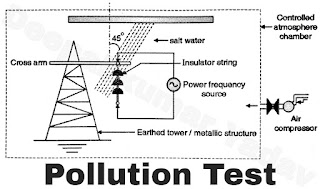Other Tests of Insulators
- Temperature Cycle Test
- Pollution Test
1. Temperature Cycle
- Test Insulators with their integral parts shall be quickly and completely immersed without being placed in an intermediate container in a water bath.
- The temperature is maintained at 70°C higher than that of the cold bath (used in the rest of the test). The insulators are left submerged for 15 minutes.
- They are then withdrawn quickly and completely immersed in the cold water bath for 15 minutes. This testing and cooling cycle is repeated for 3 times in succession.
- The time for putting the insulator from one bath to other bath should be minimum typically it should be less than 30 second. Ample amount of water should be available in the tank so that the immersion process is proper.
- The ample quantity also ensures variation in temperature of water in the range of ± 5° C After the completion of third cold cycle, the insulator is critically inspected to verify that cracks are not developed.
2. Pollution Test
- The exact procedure for this test is not yet formulated.
- Number of atmospheric constituents are to be considered viz; is dust and dirt, smoke, gases, fumes, sand particles, deposition of salt layers in coastal areas, fog, ice etc.
- Usually the test is done in controlled atmosphere condition (environmental testing lab). The test is known as salt fog test.
- The insulator string is connected to tower as shown in Figure.
- The setup is arranged in controlled atmosphere chamber.
- Artificial salty and foggy atmosphere is created around the insulator by water jets.
- High air pressure is maintained by means of air compressor.
- Power frequency voltage as per standards is applied for about one hour. The insulator should withstand the voltage without flashover.

